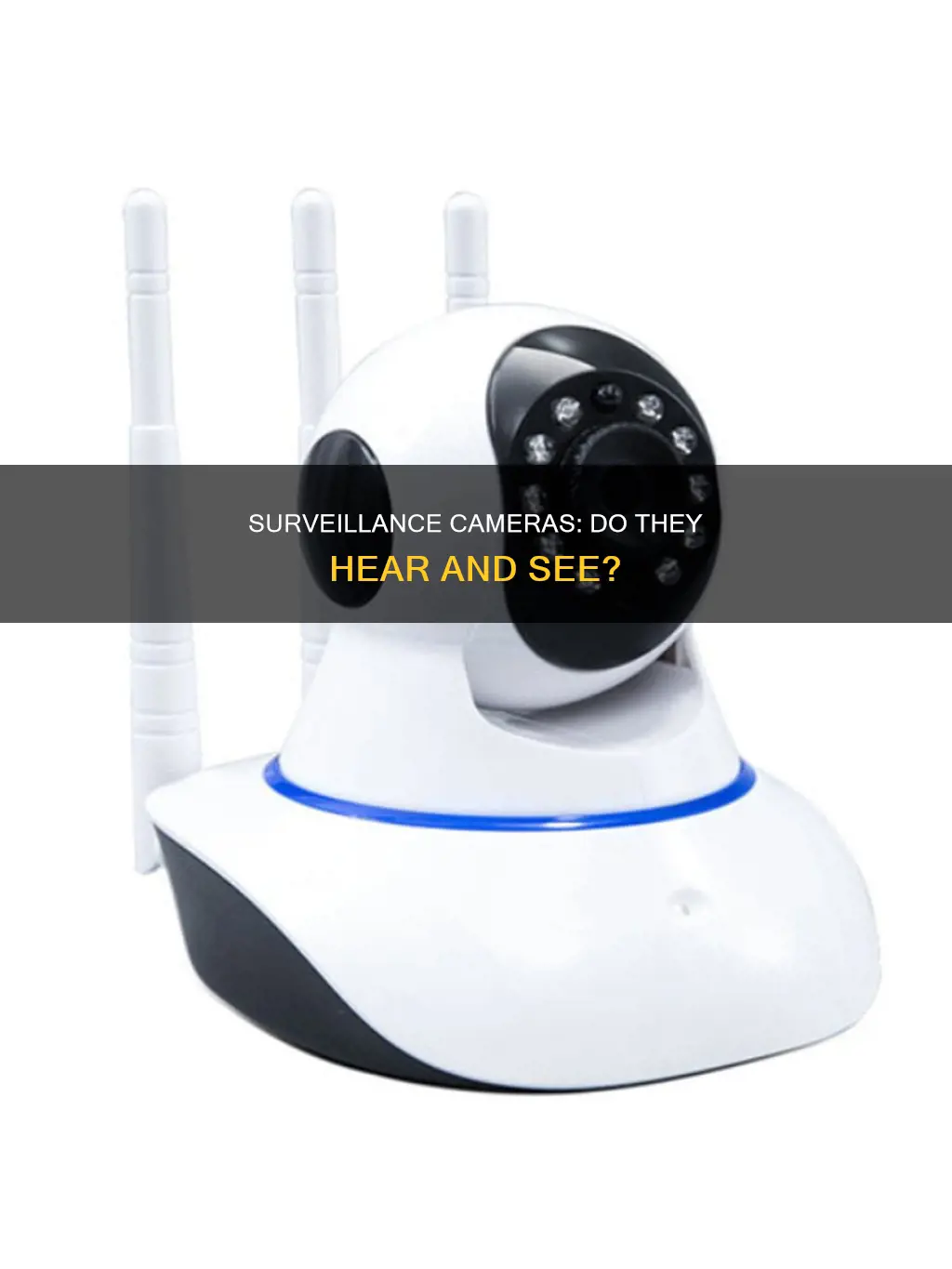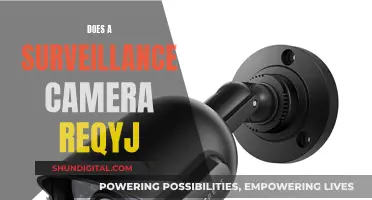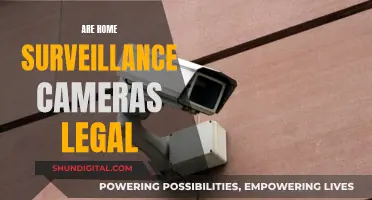
There is some confusion over audio recording and security cameras. While most modern Wi-Fi cameras (IP cameras) have built-in microphones, many older CCTV cameras do not. IP cameras can be identified by a small hole near the lens, whereas CCTV cameras will have no such hole. Some microphones are more subtle, appearing as a single hole smaller than a pinhead. The audio range of security cameras varies, but they can generally record sound from up to 6 metres away.
| Characteristics | Values |
|---|---|
| Surveillance cameras with audio | Yes, many modern security cameras have audio capabilities. |
| Types of audio | One-way and two-way audio |
| One-way audio | The camera can capture audio from its surroundings |
| Two-way audio | Users can listen to the audio from the camera's surroundings and speak through the camera to communicate with anyone nearby |
| Audio alerts | Some cameras can be set up to send alerts or notifications when specific sounds, like breaking glass or loud noises, are detected |
| Traditional CCTV cameras | Do not have audio recording |
| Modern CCTV cameras | Can have audio recording with an external microphone |
| Microphone placement | Usually near the lens. It can look like a pinhole or a small hole |
| Speaker placement | Usually on the back of the device, with dozens of holes arranged in a shape |
| Audio range | A security camera can record audio as far away as 6 meters. To pick up quiet speech, the camera must be within a couple of meters of the source |
| Audio quality | Usually low quality, especially outdoors. Highly compressed to save storage space |
| Legality | Varies by location. Generally, audio surveillance laws are stricter than video monitoring regulations |
What You'll Learn
- Surveillance cameras with audio can be used to issue warnings to intruders
- Two-way audio allows communication through the camera
- Surveillance cameras with audio can be used to monitor employees
- Surveillance cameras with audio can be used to monitor high-traffic areas
- Surveillance cameras with audio may be illegal in certain locations

Surveillance cameras with audio can be used to issue warnings to intruders
Surveillance cameras with audio capabilities can be used to issue warnings to intruders. This can be done through two-way audio systems, which allow users to listen to audio from the camera's surroundings and communicate with anyone nearby. For example, an operator can issue a warning to an intruder, informing them that they are being monitored and that the police will be notified if necessary. This type of audio warning is a vital part of remote CCTV monitoring, turning it into a preventative security measure rather than just a reactive one.
Audio warnings are often overlooked, with the focus usually being on the type of CCTV cameras and remote monitoring services. However, they are essential in deterring intruders and can save thousands of pounds in potential damage and theft. In most cases, an audio warning will deter an intruder and secure the site. In some cases, brazen intruders may remain on the site despite audio warnings, but the presence of audio warnings can still provide valuable time for security operators to implement the site's response plan, such as contacting keyholders and the police.
Modern security cameras have advanced audio features, such as one-way and two-way audio, that can be used to enhance security. One-way audio systems enable the camera to capture audio from its surroundings, providing additional context to video footage. Two-way audio systems, on the other hand, allow for communication between the user and individuals near the camera. This can be useful for confronting strangers on your property or speaking with customers and employees.
It is important to note that there may be legal ramifications for recording with a security camera system with audio features. Federal wiretap laws and local regulations often prohibit recording sound without the consent of at least one party involved. It is crucial to review the laws at the local, state, and federal levels before installing audio and video surveillance systems.
Arizona's Camera-Based Speeding Tickets: Are They Legal?
You may want to see also

Two-way audio allows communication through the camera
Two-way audio is a feature of many modern security cameras that allows users to communicate through the camera system. This means that not only can the camera's surroundings be listened to, but it is also possible to speak through the camera and communicate with anyone nearby. This functionality is enabled by built-in microphones and speakers, which are now commonly included in security cameras.
Two-way audio has a variety of applications and benefits. For example, it can be used to confront a stranger on your property or to communicate with family members when away from home. In addition, two-way audio can be used in conjunction with motion detection to trigger warnings to potential intruders, instructing them to leave the premises.
Two-way audio security cameras can be used for more than just surveillance. They can be employed in high-traffic areas to monitor people's movement and ensure their safety. They can also be beneficial for employee training and monitoring, as they allow employers to observe staff interactions with customers, clients, and coworkers, thus ensuring policy compliance and quality control.
When considering the installation of two-way audio security cameras, it is important to be aware of the legal implications. Audio surveillance laws vary from state to state and are generally stricter than video monitoring regulations. It is crucial to obtain consent from at least one party involved in the conversation before recording sound. In some states, such as California, Connecticut, and Florida, the consent of all parties is required. To avoid legal issues, it is recommended to review local, state, and federal laws or consult an attorney before installing audio-enabled security cameras.
Charging Camera Batteries: Using the Right Charger
You may want to see also

Surveillance cameras with audio can be used to monitor employees
Surveillance cameras with audio capabilities can be a powerful tool for monitoring employees, offering benefits such as enhanced security and safety, improved customer experience, and better insight into employee interactions. However, businesses must navigate complex legal considerations when implementing such systems.
Benefits of Surveillance Cameras with Audio for Monitoring Employees
Surveillance cameras with audio can be a valuable tool for businesses seeking to monitor their employees. Here are some of the key advantages:
- Enhanced Security and Safety: Audio surveillance can detect intruders who may not be in the camera's field of view. It can also capture important vocal data, providing additional context to video footage and helping security teams respond more effectively to incidents.
- Improved Customer Experience: Audio-enabled cameras can be used in high-traffic areas to monitor people's movement and ensure their safety, especially during emergencies.
- Employee Training and Quality Control: Businesses can observe how staff interact with customers, clients, and coworkers, ensuring policy compliance and helping with training.
- Reduced Theft and Vandalism: Audio surveillance can act as a deterrent to intruders and can provide additional evidence in the event of theft or vandalism.
Legal Considerations for Surveillance Cameras with Audio
While surveillance cameras with audio can provide benefits, businesses must also be mindful of legal restrictions and privacy concerns. Here are some key legal considerations:
- Consent and Notification: In most states, audio recording is only permitted if at least one party involved consents. In 12 states (including California, Connecticut, Florida, Illinois, and New Hampshire), all parties must consent to the recording. Employers must also notify employees about the presence of surveillance cameras, usually through an employee handbook or employment contract.
- Reasonable Expectation of Privacy: Surveillance cameras with audio are generally prohibited in areas where individuals have a reasonable expectation of privacy, such as bathrooms, locker rooms, and personal offices.
- Workplace Surveillance Laws: Federal wiretap laws prohibit the recording of certain oral communications. Additionally, state laws may impose further restrictions on how and where employers can conduct video and audio surveillance.
- Signage and Transparency: While not always legally required, it is considered best practice to make security cameras visible and to post signs informing employees and customers about audio and video recording.
In conclusion, surveillance cameras with audio can be a valuable tool for monitoring employees, but businesses must carefully navigate legal and privacy considerations to ensure their use of such systems is compliant and ethical.
Surveillance Cameras: How Private is Your Life?
You may want to see also

Surveillance cameras with audio can be used to monitor high-traffic areas
Surveillance cameras with audio capabilities can be used to monitor high-traffic areas, such as busy roads, highways, intersections, and transportation infrastructure. These cameras can help improve traffic flow, prevent accidents, and enhance safety and security in these areas.
For example, traffic cameras equipped with audio can be placed at traffic signals, alongside busy roads, or at intersections to monitor traffic patterns and provide alerts in case of incidents or collisions. They can also assist in preventing and investigating traffic violations, improving the efficiency of law enforcement.
Additionally, surveillance cameras with audio can be beneficial in monitoring road construction projects. They can help ensure worker safety, protect equipment, and provide security for construction sites, especially in rural or remote areas.
It is important to note that while audio-enabled surveillance cameras offer enhanced capabilities, there are also legal considerations to take into account. Audio surveillance laws vary by state and are generally stricter than video monitoring regulations. It is crucial to obtain the necessary consent and comply with local, state, and federal laws before installing and operating audio-enabled surveillance cameras in public spaces.
Overall, surveillance cameras with audio can be a valuable tool for monitoring high-traffic areas, improving safety, and facilitating efficient traffic management.
Understanding MR Mode: Camera's Memory Functionality
You may want to see also

Surveillance cameras with audio may be illegal in certain locations
Surveillance cameras with audio capabilities are becoming increasingly common. Modern security cameras can record audio and video, with some even offering two-way audio communication. However, it's important to be aware of the legal implications of using audio surveillance, as it may be illegal in certain locations.
In the United States, federal wiretap laws generally prohibit recording sound from surveillance without the consent of at least one party involved in the conversation. There are two types of consent laws: one-party consent and two-party consent. In states with one-party consent laws, individuals can record conversations as long as they are a part of the conversation or have permission from at least one party involved. On the other hand, two-party consent states require the consent of all parties involved in the conversation before recording can take place. As of 2022, there were 11 two-party consent states in the US: California, Connecticut, Delaware, Florida, Illinois, Maryland, Massachusetts, Montana, Nevada, New Hampshire, Pennsylvania, and Washington.
In addition to federal and state consent laws, there are also expectation of privacy laws that govern the use of surveillance cameras. It is generally illegal to record audio or video in places where individuals have a reasonable expectation of privacy, such as bedrooms, bathrooms, and changing rooms. These laws apply to both private residences and public spaces.
To avoid legal issues, it is crucial to understand the specific laws and regulations in your location. Before installing security cameras with audio capabilities, consult local, state, and federal laws, or seek advice from a legal professional.
How Camera Speeding Tickets Work: A Guide
You may want to see also
Frequently asked questions
Most modern Wi-Fi cameras (IP cameras) have built-in microphones, but older CCTV cameras rarely have audio recording capabilities.
Most cameras with sound have a small hole (the microphone) in the camera housing for sound pickup. This is usually located near the lens.
Yes, you can usually turn off a security camera's audio recording function using the camera's mobile app or DVR menu.







